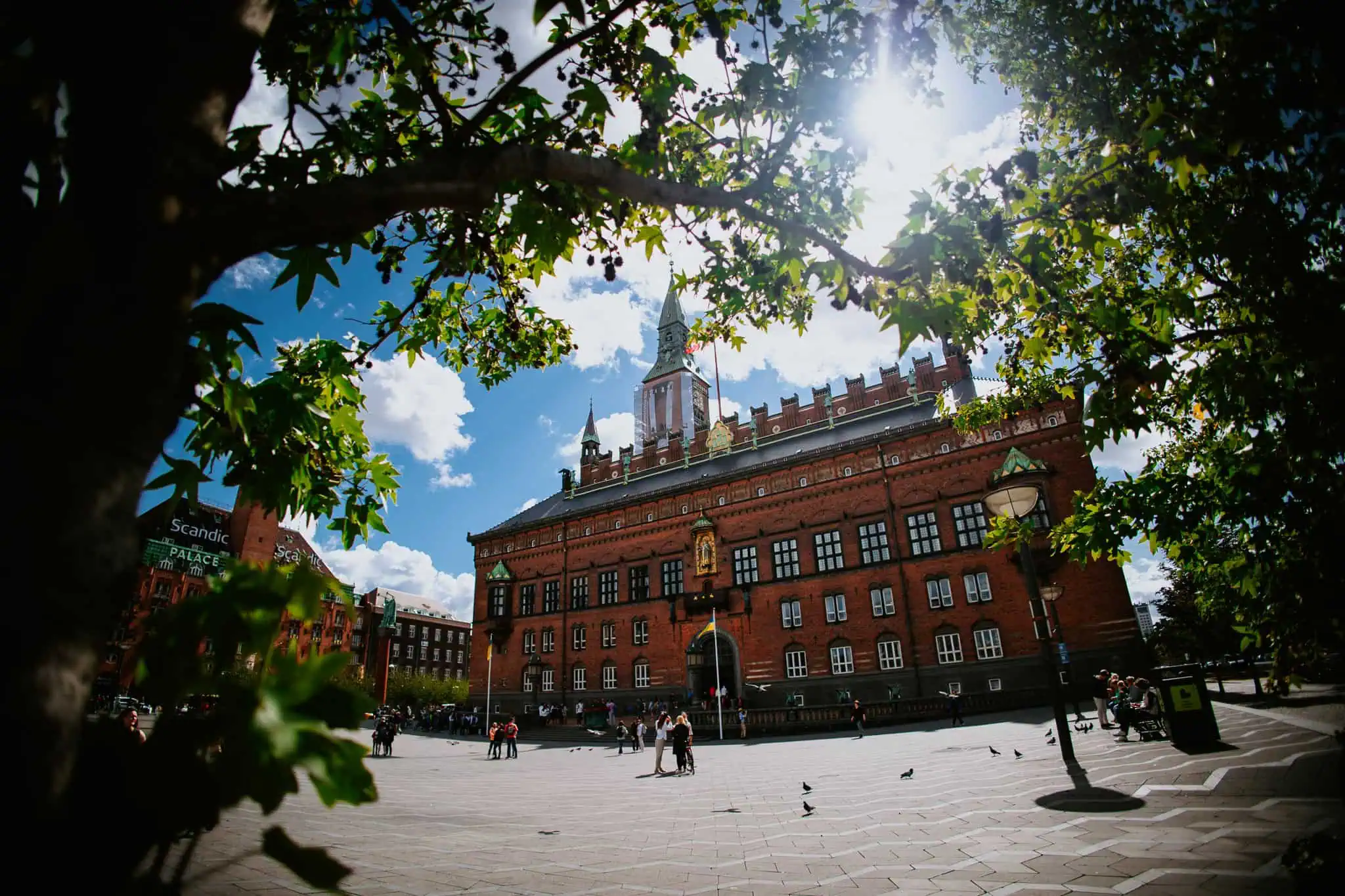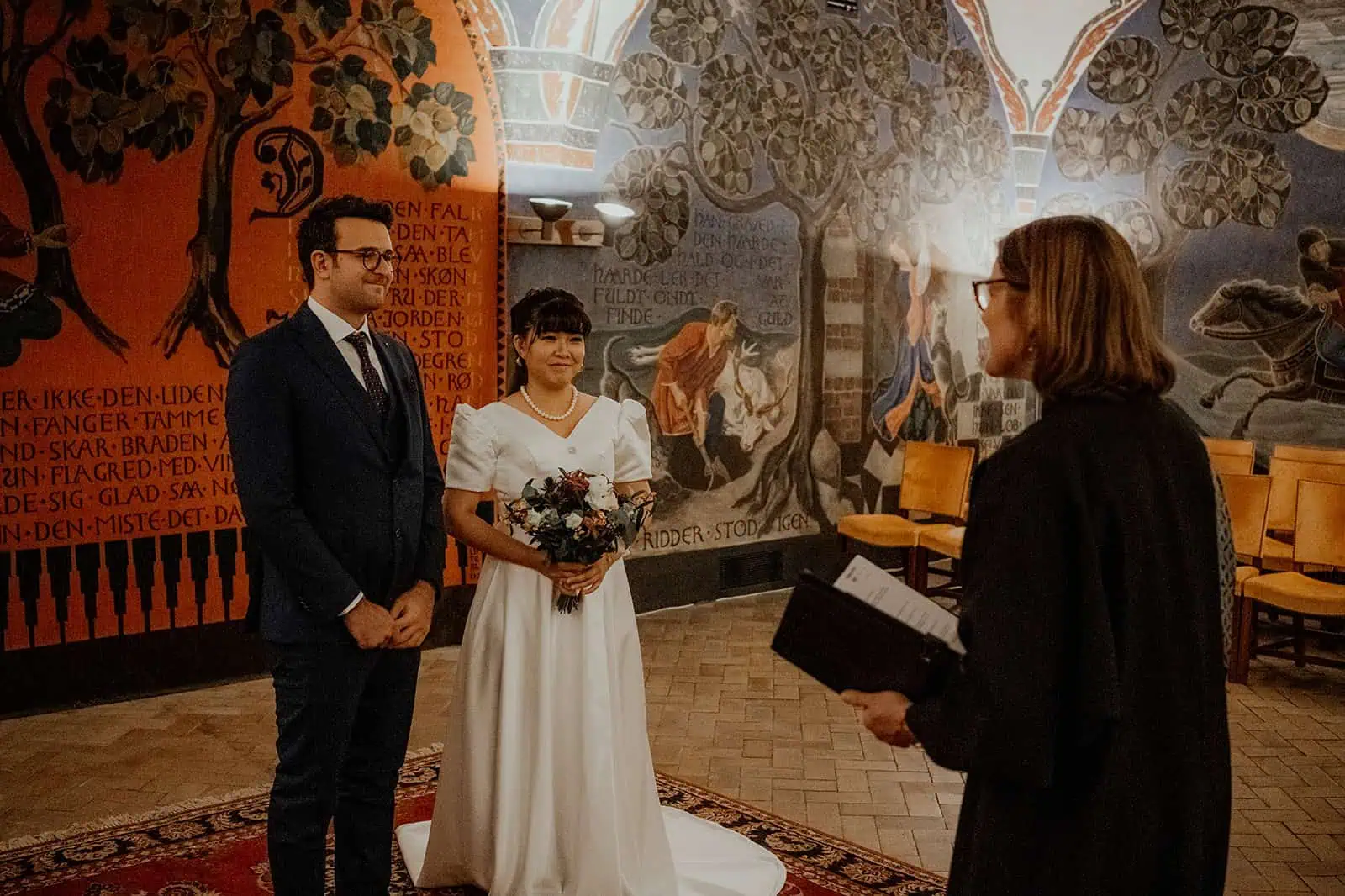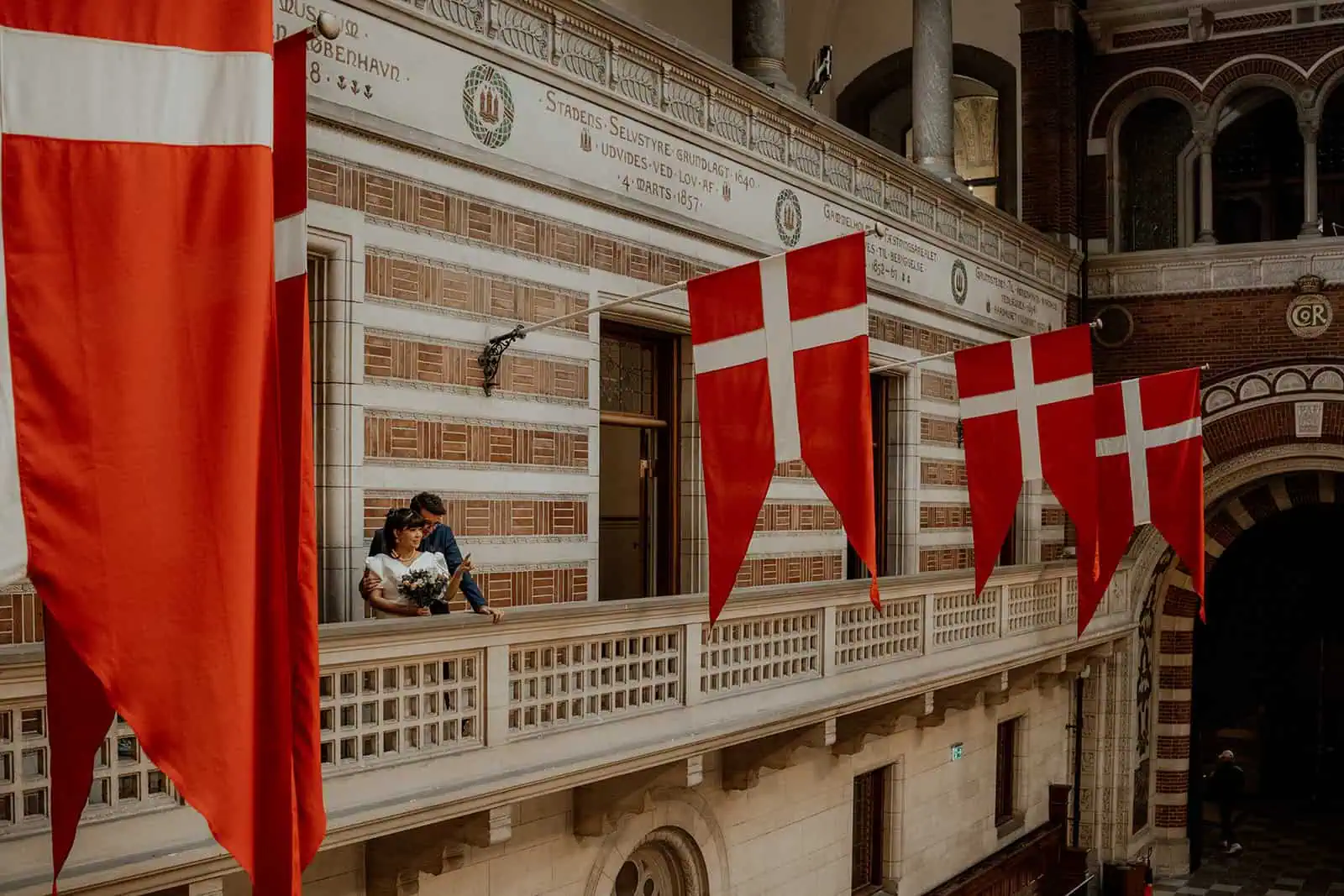Copenhagen is a very popular wedding destination, and for good reason. It’s quite simply an awesome place that sees thousands upon thousands of couples come here every year to get married. Where better to have that urban elopement?!

📍Esbjerg
Witnesses are provided by the town hall on all days and at no extra cost.
Passports and residency permits/visas, if applicable, must be presented to Copenhagen City Hall Information Desk one working day prior to your wedding date (this is Monday to Friday) between 10.00 and 14.00.
Yes, you can hire a registrar to conduct your wedding at a different location in Copenhagen, other than the City Hall, for an extra fee of €500 charged by Copenhagen City Hall

Why Get Married in Copenhagen?
Copenhagen is an incredible place. It’s cool, vibrant, safe, buzzing, with SO much to see, do and experience.
Every single couple who gets married in Copenhagen comments on how much they love this unassuming and totally understated city. In fact so much so, many couples say they want to move here.
The Copenhagen city hall is a pretty spectacular building. It is located in the heart of the city and is a magnificent presence, simply oozing history, beauty and romance!
There are a lot of weddings held in Copenhagen and for good reason. The marriage office in charge of weddings here welcomes international couples with open arms.
They hold weddings every day of the week except Sundays and even offer the possibility of getting married outside the standard wedding times – because they know just how much couples want to get married in this beautiful place.
It is also, logistically speaking, a very practical choice. It is a short (15 minutes) train or metro ride from the airport which is incredibly appealing to a lot of couples.
Then after your ceremony you’re right in the heart of the city, meaning finding somewhere to celebrate couldn’t be easier!
What will the process be on our wedding day?
Getting married in Copenhagen City Hall is a beautiful choice. When you arrive at the Copenhagen City Hall on the day of your wedding you will need to follow the small hearts placed on the floor, from the entrance through to the Great Hall.
You will reach a small stone spiral staircase located on the right side of the main hall.
The staircase is indicated by a sign saying “Bryllupssalen. Please wait here”.
When the registrar is ready for you, then they will come and collect you from this waiting area in the great hall, lead you up the spiral staircase and into the wedding hall, where your wedding will take place.

Photo Credit: Kristjan Løk
The wedding office asks couples to arrive at Copenhagen City Hall 10 minutes before their wedding.
However, we recommend arriving 20 minutes before. This will give you time to acquaint yourself with the town hall and to take a few pictures in the lovely surroundings before you head up to your wedding!
The number of weddings at the City Hall does vary, but on an average there are around 18 ‘standard’ wedding ceremonies conducted each day (except Tuesdays and Sundays).
When you arrive at the large wedding hall there is a small wardrobe where you can hang your coats. There is also a large mirror where you can check hair, makeup and ties are all in place.

The Copenhagen Wedding Ceremony
When the registrar calls your names you will follow them up the stairs into the large wedding hall, where there will be two witnesses provided by the City Hall waiting for you. These witnesses are provided as standard procedure and at no extra cost.
You are also very welcome to bring two of your own guests to act as your official witnesses instead if you’d prefer. The witnesses will sign the marriage paperwork after the ceremony.
If you want your own guests to act as witnesses they do not need to bring ID or passports, but must be 18 years old or older. You can bring a maximum of 75 people to your wedding at the City Hall.
The ceremony itself will take no longer than 5 minutes. The registrar will give a short speech about the meaning of marriage and you will then accept each other with the classic “I DO”.
If you would like, you are then very welcome to exchange rings and say your own vows (these are politely asked to be kept short), after which you will be asked to sign the marriage paperwork.
After the Ceremony
When the marriage paperwork is signed, you will receive two copies of your Danish International Marriage Certificate.
If you would like to request more than two marriage certificates then please inform your wedding consultant. Your wedding consultant will then make sure that the town hall has the requested number of certificates ready. There are no extra charges* for extra marriage certificates.
As soon as the paperwork is signed and you are handed your marriage certificates, you are free to go. The rest of the day is yours – a time for celebration and love!
*You may request up to 5 free of charge.


The Historical Wedding Room in Copenhagen
The Copenhagen City Hall wedding hall was not originally a part of the City Hall that was drawn by architect Martin Nyrup and finished in 1905.
But it was added after the popularity of civil marriages went up from a total of 628 in 1905 to 2603 in 1926 (this was a direct result of the implementation of the Marriage Act in 1922).
It would, however, take a number of years before the artwork that covers the walls would be agreed on.
The painter Joakim Skovgaard, aged 70 at the time, decided he should match Martin Nyrups Copenhagen City Hall Wedding Room extension in 1926.
Skovgaard understood that the wedding room was for non-religious ceremonies and found that a painted interpretation of the mediaeval ballad Young Svejdal fitted ideally, painted in the style and techniques of the Old Italien Frescos.
Joakim Skovgaard died in 1933, just before the wedding hall was completed.
Connected to the large hall is a balcony that gives a lovely view over the Main Hall. The perfect place for a post ceremony picture, though it’s not possible to have a ceremony on the balcony itself.

How to Get to Copenhagen City Hall?
From Copenhagen Airport to the City Hall
Driving from the airport to the city centre takes approximately 15 – 20 minutes.
Taking a taxi is also a good idea, it should cost between €35 and €45, depending on traffic.
The journey on public transport takes between 20 mins and 35 mins, depending on the route. For the routes and Metro/train/bus timetables: Have a look here.
From Hamburg (Germany) to Copenhagen
A car journey from Hamburg to Copenhagen takes around 4 h 30 minutes.
If you prefer to go by train the journey will take you approximately 6h 30 mins.
For the routes and train/bus timetables: Have a look here.
5 Things to do While We’re in Copenhagen?
What better place to get married than the capital of the happiest nation in the world!
Apart from having a wonderful time during your wedding ceremony in the lovely City Hall, you can do plenty of things in Copenhagen.
1. Experience Copenhagen's neighbourhoods by bicycle (like a true Copenhagener!)
Copenhagen has been called the best cycling city in the world; you can easily rent a bike and really get the feel of the city. There are cycle lanes everywhere and you’ll soon realise that most Copenhageners love to get around by bike!
Copenhagen’s neighbourhoods are very diverse with their own looks and vibes, yet they all have something in common: they are very loveable and interesting!
📍 Vesterbro, Nørrebro and Østerbro
The original residential areas which are now full of street life, creativity, cool restaurants and green spaces.
📍 Refshaleøen, Nordvest and Sydhavnen
The former industrial areas of the city are now hip and upcoming places full of culture, creativity and festivals, as well as authentic, tranquil harbour living.
📍 Christianshavn, Amager and Nordhavn
Copenhageners really love being close to the water. Here you can enjoy the water to the fullest while swimming or taking a boat trip, surrounded by charming, colourful houses and beautiful bridges.
📍 Copenhagen City Centre and Frederiksberg
The city centre is full of history, culture, delicious food and exciting happenings and the elegant Frederiksberg is full of green spaces and gourmet restaurants.
2. Tivoli Gardens
This amusement park founded in 1843 is a must-see, regardless of your age!
The park was loved by Hans Christian Andersen and visited by Walt Disney who was so inspired by it he built Disney World.
Tivoli is a real treasure due to the fact that there is something there for everyone.
Historic and exotic architecture, spectacular gardens and truly magical rides will leave anyone speechless.
At night thousands of lights create a unique, fairytale-like atmosphere.
When visiting, make sure to have a look at Tivoli’s restaurants and events schedule as they hold some very special music events!
3. The Little Mermaid
A bronze and granite sculpture located on Langelinie Pier.
It was unveiled on the 23rd of August 1913 as a gift from a brewer Carl Jacobsen to the City of Copenhagen.
The brewer fell in love with Hans Christian Andersen’s fairytale about the Little Mermaid after watching a ballet performance of the tale at the Royal Danish Theatre.
The Mermaid has been a victim of vandalism over the years.
Its head and arm went missing on several occasions, but the sculpture has always been quickly restored in order to welcome people to the harbour.
4. Christiansborg Palace
This impressive palace is now home to the Danish Parliament, Prime Minister’s Office and the Supreme Court of Denmark.
It’s also used by the Royal Family on some occasions.
The building is a successor to various castles and palaces built in the same place, with the first one finished in 1167.
The buildings were used by the central administration, principal residence of the Danish Kings and since 1849 they hold the Danish Parliament.
While the main part of the palace dates back to 1928, the whole building is extremely interesting from an architectural point of view as it shows three styles of the Danish architecture: Neo-baroque, neoclassical and baroque.
This is due to the fact that the palace survived two serious fires. The first one in 1794 and the second one in 1884.
Danish monarchs are proclaimed on the balcony by The Throne Room and the palace’s most impressive room , the Great Hall, holds the Queen’s tapestries.
5. Explore Copenhagen via Canal
There are many canal networks in the city and as a result many options for exploring the city by water! It’s a fantastic and unique way to see the city and even in colder weather, makes for a great experience, just wrap up warm!



